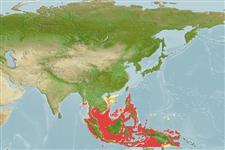Teleostei (teleosts) >
Perciformes/Scorpaenoidei (Scorpionfishes) >
Tetrarogidae (Wasp fishes)
Etymology: Neovespicula: Greek, neos = new + Latin, vespa, -ae = wasp. It is necessary to relate the fish with the insect..
More on author: Richardson.
Environment: milieu / climate zone / depth range / distribution range
Ecology
Marine; freshwater; brackish; demersal. Tropical; 22°C - 28°C (Ref. 12468); 21°N - 11°S, 94°E - 152°E
Indo-West Pacific: Indonesia, New Guinea, and the Philippines. Reports from Japan are erroneous.
Size / Weight / Age
Maturity: Lm ? range ? - ? cm
Max length : 10.0 cm TL male/unsexed; (Ref. 7050)
Dorsal spines (total): 13 - 14; Anal spines: 3. Body notably compressed. Orbit 9 - 10% SL. Dorsal soft rays 6.5-7.5; anal 4.5 (usually) to 5.5 (Ref. 39597).
Possesses venom glands at the base of some of the spines (Ref. 6192). Of no commercial interest but appear from time to time in the aquarium trade (Ref. 39597).
Life cycle and mating behavior
Maturities | Reproduction | Spawnings | Egg(s) | Fecundities | Larvae
Kailola, P.J., 1987. The fishes of Papua New Guinea: a revised and annotated checklist. Vol. II Scorpaenidae to Callionymidae. Research Bulletin No. 41, Research Section, Dept. of Fisheries and Marine Resources, Papua New Guinea. (Ref. 6192)
IUCN Red List Status (Ref. 130435)
Threat to humans
Venomous
Human uses
Fisheries: of no interest
Tools
Special reports
Download XML
Internet sources
Estimates based on models
Preferred temperature (Ref.
123201): 20.4 - 28.1, mean 26.1 °C (based on 122 cells).
Phylogenetic diversity index (Ref.
82804): PD
50 = 1.0000 [Uniqueness, from 0.5 = low to 2.0 = high].
Bayesian length-weight: a=0.01905 (0.00776 - 0.04678), b=3.03 (2.82 - 3.24), in cm total length, based on LWR estimates for this (Sub)family-body shape (Ref.
93245).
Trophic level (Ref.
69278): 3.2 ±0.3 se; based on size and trophs of closest relatives
Resilience (Ref.
120179): Medium, minimum population doubling time 1.4 - 4.4 years (Preliminary K or Fecundity.).
Fishing Vulnerability (Ref.
59153): Low vulnerability (10 of 100).
